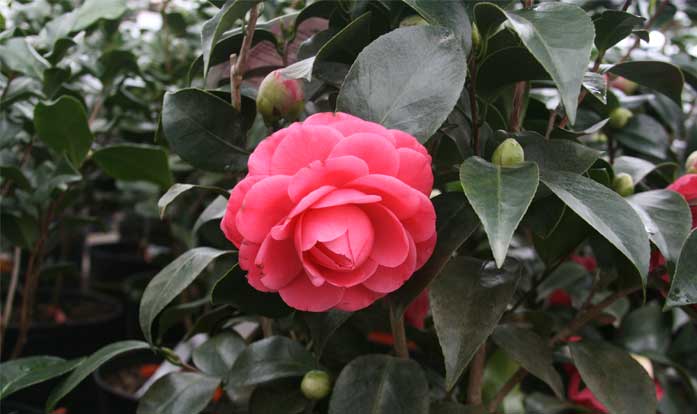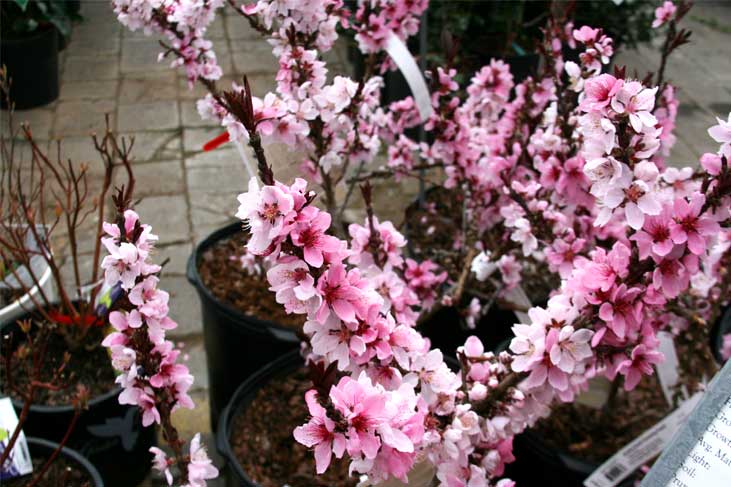Protecting Camellias from Winter Damage

It’s that time again! Camellias are blooming (or trying to) and their vibrant shades of pink, rosy-red and pristine whites are a welcome sight to winter-weary gardeners. I have seen honeybees visiting them on the warmer days of early spring, and a handful of varieties even have detectable fragrance. This recent bout of freezing weather is a good time to review techniques for protecting Camellias and other evergreens from winter damage. Many factors can cause damage to foliage and buds during the winter, but some can be mitigated by mindful care during all times of the year. Often it is not just the low temperatures that cause damage but a combination of conditions.
By planting broadleaf evergreens such as Camellias in a location not quickly warmed by the morning sun, they will stay at a more even temperature and will be less likely to “freeze-dry” the foliage due to forced water evaporation from the leaf. Naturally, wind dries out leaves as well, and is especially problematic when the frozen soil prevents the plant from replacing that lost water. Drought can have consequences months later than expected if conditions are not recognized and corrected; overly-dry soils during establishment and the beginning of hardening-off in autumn can result in more easily dried-out winter foliage due to the fact that roots didn’t develop properly. If they get watered properly, they can grow extensively and deeply enough to avoid too much frozen topsoil. Plants can, in effect, produce their own antifreeze to protect cells from being destroyed by ice crystals forming inside them; this tactic will not work, however, if the plants are not properly hydrated. Too much water, however, can be equally damaging. As many of us know, even in the warm months Camellias and many other shrubs detest poor drainage. In winter, waterlogged soils that take too long to thaw can also kill roots, because the excess moisture that has surrounded the roots prevent enough oxygen from reaching them and cause root death. In this case, ironically, exposure to warming sun can help thaw the soil and save the plants. Since soils can be amended for better drainage, it is still a better choice overall in our area to pick a site for Camellias that is in filtered shade in the winter, either from a building or overhead evergreen. Such a barrier also can help provide a wind screen.

If Camellias and other evergreens are damaged by a harsh winter, give them until early summer to determine if they did, in fact, perish; it can take that long to do so but many moderately-damaged plants generally recover. As always, late-season pruning this coming summer should also be avoided as this interferes with dormancy preparations and can delay proper hardening-off, causing stems to be more prone to breaking and plants to be less tolerant of cold and fluctuating temperatures.
Good detailed information on growing Camellias in our area can be found in Dr. William Ackerman’s book, “Beyond the Camellia Belt.” Although published in 2007, the information is still timely and highly relevant to our area since Dr. Ackerman lived in Maryland and worked for many years at the U.S. National Arboretum on Camellia breeding and observing cold-hardiness.
 Dwarf peach trees are in full bloom now!
Dwarf peach trees are in full bloom now!
Our Camellia stock has arrived and is currently being sheltered from the worst of the weather in our cold greenhouse (we keep it as cold as we can but only use heaters to keep it from freezing); stop in and visit if you want to see their wonderful flowers, even if you aren’t ready to plant yet. We also have a lot of trees and other shrubs that are starting to bloom in there; since they may finish blooming before the freezing nights are behind us, check them out to see if any interest you. (We can share pictures but we can’t share fragrance!) It’s unfortunate that they won’t get much of an audience in there, but we look forward to more blooms once this passes!
by Miri Talabac, Woody Plant Buyer

This Post Has 0 Comments